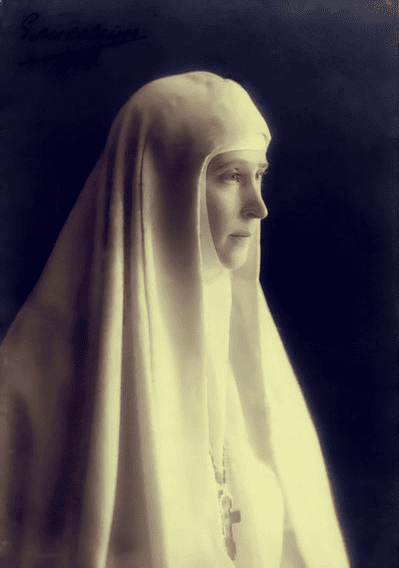A Crown, But Not On This Earth
Look at that face. It belongs to St. Elizabeth the New Martyr. She was a Romanov Grand Duchess, German-born and the sister of Tsarina Alexandra, as well as married to Grand Duke Serge, a cousin of the Tsar. Excerpt:
Grand Duke Serge was killed by an assassin’s bomb on February 4, 1905, just as St Elizabeth was leaving for her workshops. She visited her husband’s killer in prison and urged him to repent, giving him an icon. She eventually built a shrine over the site of her husband’s martyrdom (which was said to have been destroyed by Vladimir Lenin himself in 1917).
After her husband’s murder, she began to withdraw from her former social life. She founded the Convent of Sts. Martha and Mary in Moscow, a community of nuns which focused on worshiping God and helping the poor. She sold all her fine clothes and jewels, and moved out of her palace into the buildings that she had purchased on behalf of the convent.
St. Elizabeth and her sisters continued to visit the poor and hungry in Moscow. During the First World War, she nursed sick and wounded soldiers in the hospitals and on the battle front. She was respected and admired throughout Russia and people came to her for spiritual direction.
After her brother-in-law, Tsar Nicholas II, abdicated the throne and he and his family were placed under house arrest, St. Elizabeth was urged to abandon her convent and seek shelter with her remaining family in Western Europe. She refused all offers of help, saying she would not leave the other sisters and would die in Russia if that was His Will.
On Pascha 1918, Soviet soldiers came to the convent and ordered her to leave Moscow to join the royal family near Ekaterinburg. She was allowed to leave with a novice, Sister Barbara, but was not permitted to say goodbye to the other sisters.
After arriving in Ekaterinburg, St. Elizabeth was denied access to the Tsar’s family. She and Sister Barbara were placed in a convent, where she was warmly received by the sisters.
At the end of May St. Elizabeth and St. Barbara were moved to the nearby village of Alopaevsk with the Grand Dukes Sergius, John, and Constantine, and the young Count Vladimir Paley. They were all housed in a schoolhouse on the edge of town. St. Elizabeth was placed under guard, but was permitted to go to church and work in the garden.
On the night of July 5, they were all taken to a place in the woods, twelve miles from Alopaevsk, and executed. Grand Duke Sergius was shot, but the others were thrown down a mineshaft, with grenades being tossed in after them. St. Elizabeth lived for several hours, and could be heard singing hymns by local villagers who came up to the mineshaft after the murderers had left.
That face. Those eyes.


Subscribe for as little as $5/mo to start commenting on Rod’s blog.